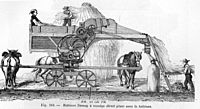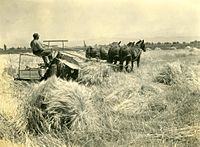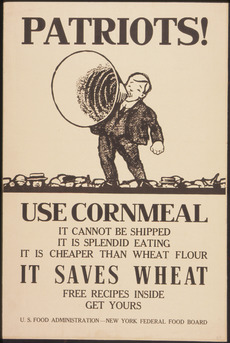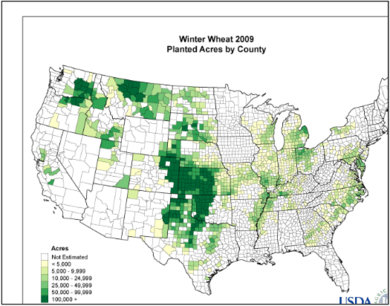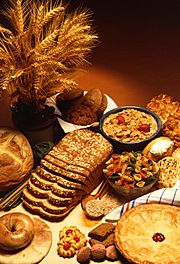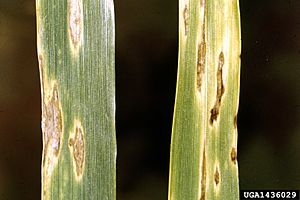Wheat production in the United States facts for kids
Wheat is a super important grain grown in almost every state in the United States. It's the main type of grain grown in the country! The US is one of the top wheat producers in the world, coming in fourth place in 2020 with nearly 50 million tons. Only China, India, and Russia grow more. What's really cool is that the US is the number one country for exporting wheat, sending almost half of its total production to other countries.
The United States Department of Agriculture (USDA) has eight official types of wheat. These include durum wheat, hard red spring wheat, hard red winter wheat, and soft red winter wheat. Most of the wheat grown in the US is winter wheat, making up about 70% to 80% of the total. The states of Kansas and North Dakota grow the most wheat. The US also exports a lot of its hard red spring wheat, sending it to over 70 countries. Overall, about 50% of all US wheat is exported, which is worth about $9 billion!
Contents
How Wheat Farming Started in the US
Wheat first came to the Americas after the discovery of the New World. One story says that a slave of Hernán Cortés found some wheat grains in rice that came from Spain in the 15th century. Later, a monk named Friar Jodoc Riri de Gante planted the first wheat kernels in Quito, Ecuador.
Wheat started growing in North America during the colonial period. Back then, farmers planted wheat by simply throwing seeds everywhere (called broadcasting). They used tools like sickles to cut the wheat and flails to separate the grain from the stalks. After that, the wheat kernels were taken to a mill to be ground into flour.
Big Changes in the 1800s
In 1830, it took four people and two oxen working 10 hours a day to produce 200 bushels of wheat. Over time, wheat farming spread further west across the country. Farmers also started growing wheat in tougher climates. Experts worked on making better types of wheat in the US, while federal officials looked for good varieties from other parts of the world.
After the American Civil War, wheat farming grew a lot in the western Mississippi Valley and the Great Plains. These areas had huge, fertile lands. Farmers started using better tools, and railroads made it easier to send wheat to markets around the world. New storage facilities also helped. A big change was the introduction of hard winter wheat. In the 1870s, Russian Mennonite immigrants brought a tough wheat type called Turkey red wheat to Kansas. This wheat spread quickly.
New technology really boosted how much wheat farmers could grow in the 1800s. Planting with drills replaced broadcasting, and cradles took the place of sickles. Then, reapers and binders replaced cradles. Steam-powered threshing machines took over from flails. By 1895, on huge farms in the Dakotas, it took six people and 36 horses pulling giant harvesters to produce 20,000 bushels in a 10-hour day! After a new type of mill was invented in 1878, hard wheat varieties like Turkey Red became more popular because they were easier to grind into flour.
Wheat in the 1900s and Today
From 1914 to 1922, the US exported over 200 million bushels of wheat. The amount of wheat grown in the US more than tripled between 1871 and 1921. It went from about 250 million bushels to over 750 million bushels! When World War II started, the US had much more wheat than it needed. Because it couldn't all be exported, some was used to feed animals and make industrial alcohol. After the war, from 1945 to 1948, wheat production was even higher, averaging 1,228 million bushels per year.
In 2002, half of the US wheat crop was exported. About 36% was eaten by people in the US, 10% was fed to animals, and 4% was saved for planting new crops. Wheat is harvested from about 60 to 63 million acres of land. In 2013, some Genetically modified wheat was found on a farm in Oregon. This wheat was changed by Monsanto to resist weed killer. This type of wheat is not approved for growing anywhere in the world, and it's not known if it's present in other places.
Where Wheat Grows in the US
The Wheat Belt is a long area in the North American plains where a lot of wheat is grown. It stretches for about 1,500 miles from central Alberta in Canada all the way down to central Texas.
Hard red winter wheat is grown in southern US states like Kansas, Oklahoma, Texas, Nebraska, and Colorado. In these warmer places, winter wheat is planted in the fall and harvested in the spring, using the autumn rains to help it grow. In colder states like Montana, North Dakota, South Dakota, and Minnesota, winter wheat can't survive the harsh winters. So, farmers plant spring wheat in the spring, and it grows during the long summer days, ready to be harvested in the fall.
Types and Uses of Wheat
As we mentioned, about 36% of US wheat is eaten by people, 50% is exported, 10% goes to animal feed, and 4% is used for planting new seeds. You might also find different kinds of wheat beer made in the US.
Wheat in the US is mainly grown in two categories based on the climate: winter wheat and spring wheat. Winter wheat makes up about 75% of all wheat production. Here are the main types of wheat:
- Hard red winter wheat (HRW): This type makes up about 40% of production. It's mostly used for making flour. It grows in the high plains, from Texas through Kansas (the biggest producing state) and up to the Dakotas and Montana.
- Hard red spring (HRS) wheat: This wheat has a lot of protein and makes up about 20% of production. It's great for making high-quality bread. It's grown in North Dakota, Montana, Minnesota, and South Dakota.
- Soft red winter (SRW) wheat: This type makes up about 20% of production. It's grown in states like Ohio, Kentucky, Indiana, Washington, Oregon, Idaho, Michigan, New York, and the Southeast. The flour from this wheat is used to make cakes, cookies, and crackers.
- White wheat: This accounts for about 12.5% of production. It's grown in Washington, Oregon, Idaho, Michigan, and New York. Its flour is used for soup noodles, crackers, cereals, and white-crusted breads.
- Durum wheat: This is the best type of wheat for making pasta. It's mostly grown in Arizona, North Dakota, and Montana, making up about 4% of production.
The leftover parts from milling all these wheat types are used to feed animals.
Making Wheat Flour Healthier
In 1941, the wheat industry started adding extra vitamins, folic acid, and iron to wheat flour. This was done to make people healthier, especially after a conference found that many World War II recruits had poor health. By 1942, about 75% of breads in the US were fortified. In 1943, it became a rule to add these nutrients to flour.
When grains are processed, some natural nutrients are removed. This can lead to diseases caused by not getting enough nutrients, like beriberi, pellagra, and iron deficiency anemia. Adding these nutrients back into flour helped to get rid of or reduce these health problems in the United States.
Rules and Support for Wheat Farmers
During World War I, the U.S. Food Administration, led by Herbert Hoover, set a basic price for wheat. After the war, wheat prices dropped a lot because there wasn't as much demand from other countries. This led to new laws and programs to help farmers.
Today, the most important laws for wheat production in the US are the farm bills. These bills, which are updated about every five years, allow for things like farm subsidies (money given to farmers), the Conservation Reserve Program, and other helpful programs. Recent farm bills include those from 1985, 1990, 1996, 2002, and 2008.
Wheat farmers get a lot of help from these programs. From 1995 to 2012, the US government paid over $39 billion in wheat subsidies. This money came from different programs designed to support wheat farmers and their production.
How Wheat is Produced
The United States is a major wheat-producing country. Usually, only China, the European Union, and India produce more. The amount of land used for wheat farming has changed over the years, often depending on the price of wheat. In the early 2000s, wheat was the third most important field crop in the US, after corn and soybeans. The amount of land used for wheat has gone down by almost 30% in recent decades. The amount of wheat exported has also decreased.
Wheat and the Environment
Growing wheat in the off-season can be good for the environment. Depending on the climate, planting wheat in late fall or early spring means farmers might use less fertilizer and pesticides, and need less water for irrigation. It also helps prevent soil erosion.
However, there can be some negative effects. For example, growing wheat can sometimes lead to the loss of natural habitats if new lands are used for farming. This can affect the variety of plants and animals in an area. Also, the process of milling wheat can cause dust pollution. In the western US, land is still being converted for farming, partly because government support for wheat and other crops makes it profitable to use land that might otherwise be left alone. However, the expansion of land for wheat farming has mostly stopped since 2000.
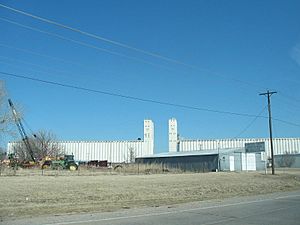
Exporting Wheat
Almost 50% of the wheat grown in the US is exported to other countries. However, the US share of the world market has gone down because of competition from places like the EU, Argentina, Australia, Canada, and more recently, Ukraine and Russia. The main types of wheat exported are hard red winter, white wheat, hard red spring, soft red winter, and durum wheat. Even with more competition, US producers continue to increase exports because wheat products haven't been as popular in the domestic market recently.
One export policy that was criticized was called PL 480 (Public Law 480), which lasted from 1954 to 1969. India received a large share of this aid, about 50%. Some people criticized this policy because they felt it hurt the export chances of other countries, like Canada and Australia. It was also said that this policy discouraged countries from developing their own agriculture. In India, this aid even caused many farmers to go bankrupt.


